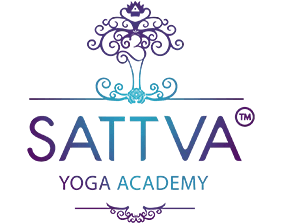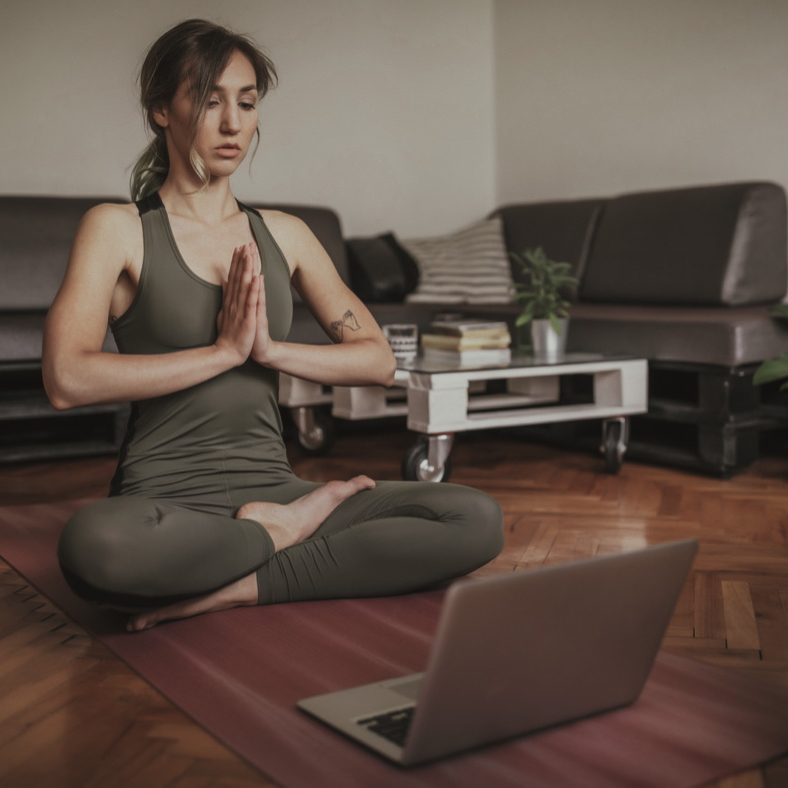Introduction
Enrollment in Yoga teacher training online courses is booming, showing how popular this flexible learning option has become. These courses transform traditional yoga sessions into a virtual format, making them:
Accessible: Students can join from anywhere, eliminating travel.
Flexible: Learners set their own schedules, which helps fit yoga training into busy lives.
However, studying online also poses challenges:
Self-discipline: Students must motivate themselves without a teacher’s physical presence.
Practice space: Learners need to create their own peaceful area at home.
Yet, the benefits are clear:
Diverse learning: Online courses offer teachings from various global instructors.
Interactive tools: Many programs use videos and live streams to enhance learning.
These features help students not only learn but thrive in their journey to becoming yoga instructors.
Personalising Your Learning Pathway
Assessing Your Learning Style
Embarking on a Yoga teacher training online course invites you to understand and adapt to your learning style. Whether you prefer visual, auditory, or kinesthetic methods, online training offers unique tools to cater to your needs.
Visual Learners:
Videos and Diagrams: Engage with detailed yoga posture videos. These help visualise the flow and precision needed for each pose.
Reading Materials: Use illustrated ebooks and infographics that break down complex yoga theories into understandable chunks.
Auditory Learners:
Audio Recordings: Listen to lectures and guided practices. Replaying audio helps reinforce lessons and techniques.
Discussion Forums: Participate in online discussions where you can listen to peers and instructors sharing insights and experiences.
Kinesthetic Learners:
Interactive Simulations: Engage with virtual reality settings that mimic a yoga studio. This tech allows you to ‘feel’ the space around you.
Practice Along Videos: Perform yoga sequences along with the video. This method helps embody the teachings through physical practice.
Tools and Apps to Customise Learning Experiences
With the right tools, you can tailor your Yoga teacher training online course to fit your personal learning preferences. Here’s how you can use technology to enhance your learning:
Customizable Learning Platforms: Choose platforms that allow you to adjust content delivery according to your learning style. For instance, platforms that offer text, audio, and video interchangeably.
Mobile Apps: Utilise apps that provide practice routines, flashcards, and progress tracking. These can help keep your training consistent and on track.
Virtual Workshops: Attend live online workshops that offer real-time interaction. These sessions are excellent for getting immediate feedback and for engaging in more tactile learning experiences.
Feedback Tools: Use apps that record your practice sessions and provide feedback through AI or instructor reviews. This technology helps refine your technique and alignment, essential for both personal practice and teaching.
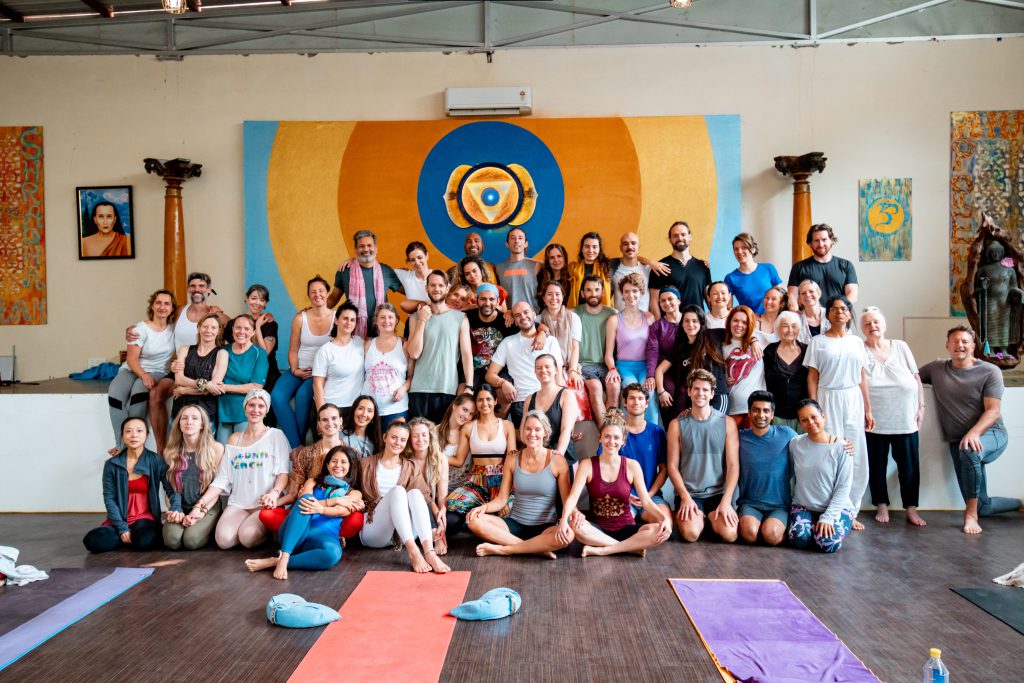
Customizing Course Content
Adapting the course content to meet individual needs and goals is crucial in a Yoga teacher training online course. Here’s how you can personalise your learning experience to ensure it aligns with your personal and professional aspirations.
Tips for Adapting Course Materials
Set Clear Objectives: Before starting, define what you hope to achieve with your yoga training. Are you looking to deepen your practice, or do you aim to teach? Knowing your goals helps tailor the course content.
Choose Elective Modules: Many online courses offer elective topics alongside core subjects. Select modules that align with your interests, such as advanced asanas, yoga philosophy, or therapeutic yoga practices.
Modify Study Pace: Utilise the flexibility of online learning to adjust the pace of the course. If you grasp concepts quickly, you might accelerate your study. If you need more time to understand certain principles or practices, slow it down.
Seek Additional Resources: Supplement your course materials with external resources like books, podcasts, or additional online workshops. This can enhance your understanding of complex subjects.
Role of Personalized Learning Plans
Enhanced Engagement: Personalized learning plans in a Yoga teacher training online course keep students engaged. When you study content that resonates with your interests and goals, you’re more likely to stay motivated.
Better Retention: Customising your learning path helps improve information retention. When learning methods match your personal style, you absorb and recall information more efficiently.
Feedback Integration: Regular feedback from instructors on your progress can guide adjustments in your learning plan. This responsive approach ensures that the course continually meets your evolving needs.
Community Interaction: Engage with a community of learners who have similar goals. This can lead to a more enriching learning environment where you share insights, ask questions, and receive support.
Creating a Multisensory Learning Environment
A. Engaging All Senses
When participating in a Yoga teacher training online course, creating a learning environment that engages all your senses can significantly enhance your ability to absorb and retain information. Here’s how to set up a home yoga space that stimulates sight, sound, smell, and touch, transforming it into a sanctuary of learning.
Sight:
Lighting: Ensure your space is well-lit with natural light or soft, warm artificial lights to reduce eye strain and create a calming atmosphere.
Visual Calm: Decorate your space with soothing colours and minimalistic decor to reduce visual clutter and enhance focus.
Instructional Visuals: Set up a monitor or tablet in your practice area to clearly see detailed postures and follow along with tutorials.
Sound:
Acoustic Setting: Use a quiet room or soundproof your space if possible. This minimises distractions and allows you to focus on the audio components of your course.
Ambient Sounds: Consider playing soft background music or nature sounds to create a peaceful environment conducive to learning.
Smell:
Aromatherapy: Incorporate elements like incense or essential oil diffusers with lavender or sandalwood to enhance concentration and relaxation.
Touch:
Tactile Props: Use high-quality yoga mats, cushions, and blankets that provide comfort and support during practice.
Textured Surfaces: Choose materials like cork or textured fabric for your yoga accessories to heighten the physical experience of touch.
Suggestions for Yoga Accessories and Technology That Enhance the Sensory Experience
Smart Yoga Mats: Invest in a smart mat that provides feedback on your poses, helping to refine your technique and alignment.
Virtual Reality (VR): Use VR headsets to immerse yourself in a virtual yoga studio, offering a more engaging and interactive learning experience.
Wearable Technology: Consider fitness trackers or smartwatches to monitor your heart rate and stress levels during practice, helping you understand your body’s responses.
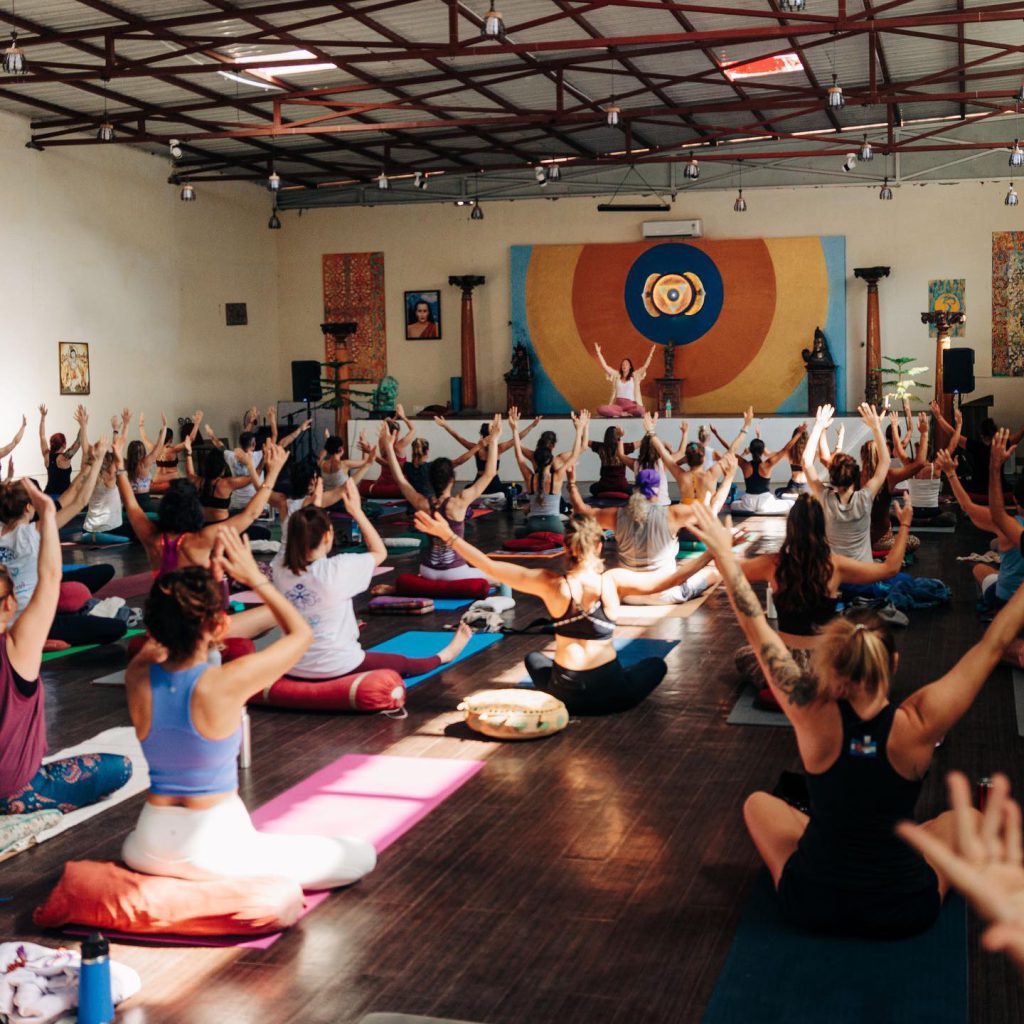
Virtual Reality and Augmented Reality
Incorporating Virtual Reality (VR) and Augmented Reality (AR) into a Yoga teacher training online course can revolutionise how we understand and practice yoga. These technologies offer immersive experiences that can mimic a classroom setting and enhance the learning process.
Exploring the Use of VR and AR in Practising Yoga Postures
VR Yoga Studios: VR can transport you to a virtual yoga studio where you can practise alongside digital instructors. This setup is perfect for students who crave the class environment but are learning from home.
Precision in Postures: With VR, every angle of a yoga posture can be explored. This technology provides a 360-degree view, helping you understand the alignment and positioning of each pose with greater clarity.
Interactive Feedback: Some VR platforms are equipped with sensors and software that analyse your postures and provide real-time corrections and feedback, much like a physical instructor would.
Using AR for Anatomy Study
Overlay Information: AR can overlay anatomical charts and muscle movements over your body while you practise. This feature helps visualise which muscles are engaged during each pose, enhancing your anatomical knowledge and the effectiveness of your practice.
Detailed Visualisation: Through AR, you can see detailed animations of internal processes, like breathing or the circulation system’s response during yoga practices, which can be pivotal for teaching about yoga’s physiological benefits.
Simulating Classroom Experience with VR and AR
Immersive Learning Environments: Both VR and AR can create immersive environments that simulate being in a yoga class. This includes visualising a studio, hearing the instructor’s voice, and even interacting with other virtual students.
Enhanced Understanding: These technologies foster a deeper understanding by allowing students to experience direct and immediate visualisation of teachings and corrections. This immersive interaction goes beyond traditional video or live stream by providing a more tactile sense of learning.
Gamification of Learning
Incorporating Play and Competition
Gamification can significantly enhance the engagement and effectiveness of a Yoga teacher training online course by integrating elements of play and competition. This approach not only makes learning more enjoyable but also motivates students through challenges and rewards.
Examples of Gamifying Your Study Routine
Progress Levels: Just like in a game, you can set levels in your training course. Start as a beginner and advance through intermediate to expert, unlocking new content and complex poses as you progress.
Challenges and Missions: Incorporate weekly challenges, such as mastering a new pose or improving flexibility scores. Completing these can earn badges or points, adding a fun competitive edge.
Timed Quizzes: Use quizzes that require answering questions under time constraints. This can be about pose names, sequences, or yoga philosophy. Timed challenges can sharpen your knowledge and quick decision-making skills.
Using Apps That Introduce Elements of Scoring, Levels, and Achievements
Yoga Learning Apps: Many apps are designed to help you track your progress in a Yoga teacher training online course. These apps can include scoring systems for each module completed, feedback on posture alignment, and even breath control.
Achievement Badges: Earn badges for various milestones, such as completing a meditation streak or achieving a personal best in complex asanas. Display these badges in your profile to showcase your accomplishments.
Leaderboards: Some apps feature leaderboards where you can compare your scores and progress with other students. This fosters a sense of community and healthy competition, pushing you to strive harder.
Benefits of Gamification in Learning
Increased Motivation: By turning learning into a game, students are more likely to remain engaged and motivated throughout their course.
Enhanced Retention: Gamification makes the retention of information easier and more enjoyable, as interactive elements help reinforce knowledge through active participation.
Community Engagement: Engaging with other learners in a competitive environment can lead to a more vibrant and supportive community, enhancing the learning experience for everyone involved.
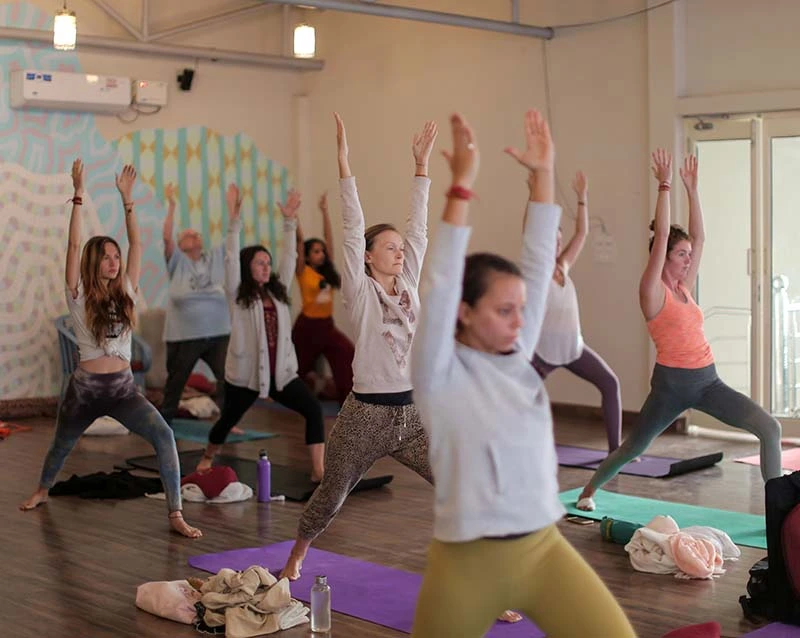
Reward Systems
Implementing reward systems in a Yoga teacher training online course can significantly boost motivation and enhance the overall learning experience by celebrating milestones and recognizing personal accomplishments.
Creating Personal Reward Systems
Setting Milestones: Begin by defining clear, achievable milestones within your yoga training course. These could be completing a set number of modules, mastering a challenging pose, or achieving a certain number of practice hours.
Rewards for Achievements: Tie these milestones to specific rewards. For example, after completing a difficult section, treat yourself to a yoga-related reward like a new yoga mat or a workshop with a renowned teacher. These rewards not only celebrate your progress but also contribute to your ongoing practice.
Regular Celebrations: Make a habit of celebrating smaller weekly or monthly achievements. This could be as simple as taking a day off for self-care or indulging in your favourite treat. Regular recognition of efforts keeps spirits high and discourages burnout.
The Psychological Benefits of Rewarding Oneself
Increased Motivation: Rewards can significantly enhance motivation, especially in a self-directed learning environment like an online course. When you know a tangible reward awaits your achievement, you’re more likely to push through challenges and stay committed to your goals.
Positive Reinforcement: Rewarding yourself reinforces the behaviour you want to cultivate, such as consistent practice or diligent study. This positive reinforcement helps establish long-term habits that are beneficial not only for the course but for ongoing yoga practice.
Emotional Satisfaction: Achieving a goal followed by a reward provides emotional satisfaction, which is crucial during the demanding periods of an intensive course. This satisfaction can rejuvenate your enthusiasm and passion for learning.
Stress Reduction: Rewards can also serve as a form of stress relief, offering a break and a psychological breath of fresh air amidst the rigorous demands of training.
Leveraging Digital Tools for Time Management
Advanced Scheduling Techniques
Effective time management is essential in Yoga teacher training online courses, where self-directed learning requires disciplined scheduling and organisation. By integrating sophisticated digital tools and project management techniques, you can enhance your efficiency and ensure all training milestones are met.
Using Project Management Tools and Techniques
Project Management Platforms: Leverage tools such as Asana, Trello, or ClickUp. These applications allow you to break down your yoga course into distinct tasks, each with its own timeline and objectives. This breakdown helps in managing your study load and tracking your progress through each module.
Detailed Scheduling: Plan out each week by assigning specific learning modules to different days. For instance, dedicate Mondays to studying asanas, Tuesdays for pranayama techniques, and so on. This helps establish a routine, making your training predictable and manageable.
Visual Progress Tracking: Use the visual boards in these tools to monitor your advancement. Colour-code tasks based on status—completed, in progress, or pending. This visual aid not only keeps you organised but also motivates you by visually representing your progress.
How to Effectively Use Reminders and Alerts
Digital Calendars: Sync your study schedule with digital calendars like Google Calendar or Apple Calendar. Set detailed reminders for each session, including live classes, study times, and deadlines for assignments.
Reminder Apps: Employ reminder apps that can nudge you about upcoming deadlines or scheduled study times. Apps like Todoist or Remind can push notifications to your phone or computer, ensuring you stay on track.
Routine Reviews: At the beginning of each day, review your calendar and adjust as necessary. This daily review helps you prioritize tasks, adapt to any changes, and prepare mentally for the day’s learning objectives.
Benefits of Advanced Scheduling Techniques
Enhanced Productivity: By clearly defining your study times and objectives, you minimise wasted time and maximise learning effectiveness.
Stress Reduction: Proper scheduling alleviates the anxiety of cramming and the stress of last-minute preparations, making your learning experience more enjoyable.
Flexibility and Adaptability: With a well-organised schedule, you can easily adjust your plans to accommodate unexpected changes or additional commitments, ensuring a balanced approach to your training.
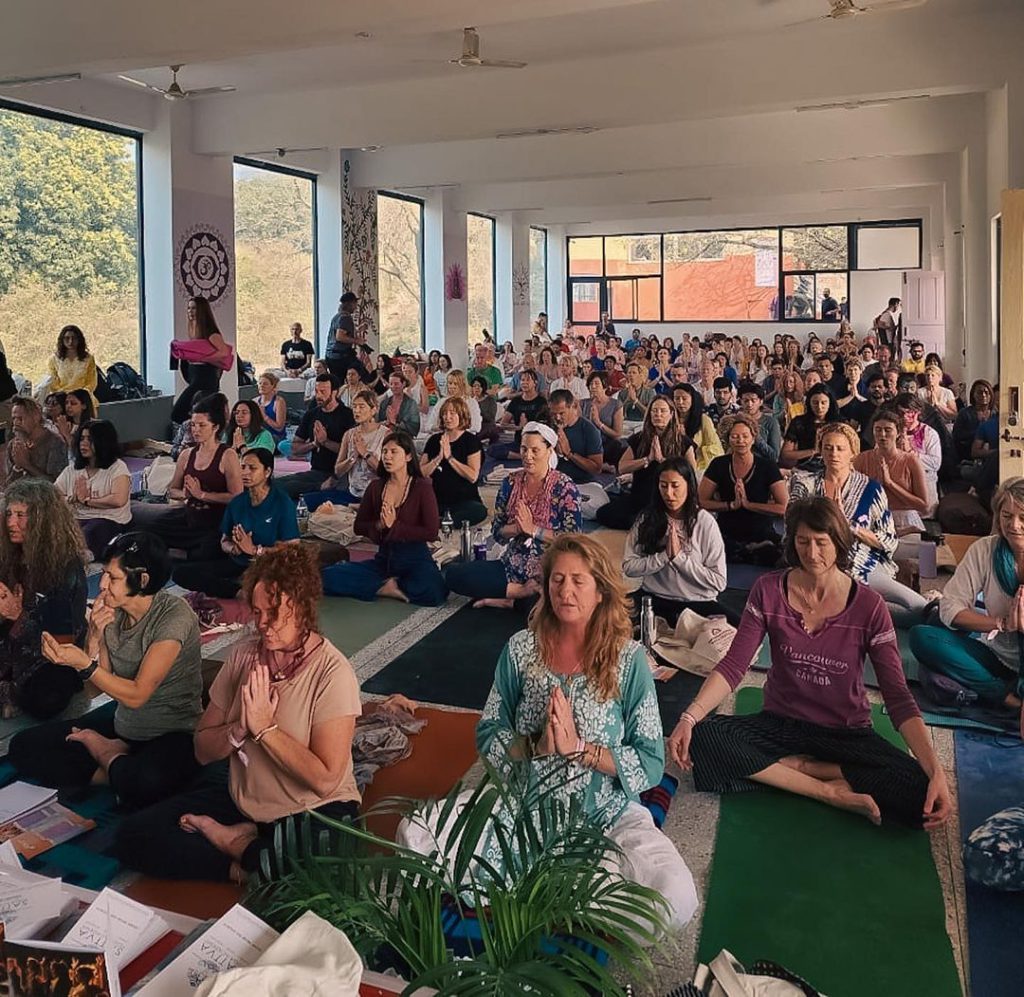
Integrating Learning into Daily Life
Incorporating the curriculum of Yoga teacher training online courses seamlessly into your everyday routine can greatly enhance the learning experience and ensure consistent progress. Utilizing strategies like microlearning and mobile apps can transform spare moments into valuable learning opportunities.
Strategies to Incorporate Microlearning Sessions Throughout the Day
Scheduled Micro-Sessions: Divide your day into short, manageable learning intervals. For example, dedicate 10 minutes in the morning to revising yoga philosophy and another 10 minutes in the afternoon to anatomy flashcards. This method ensures continuous engagement with the material without overwhelming you.
Learning in Context: Apply yoga principles during daily activities. Practise mindful breathing while waiting in line or adopt posture-correcting techniques at your desk. Integrating practical aspects of yoga into your routine helps reinforce your learning in real-world settings.
Responsive Learning: Adjust your microlearning schedule based on your daily energy levels and tasks. If you find mornings are when you’re most alert, use that time for complex topics. Reserve easier, more reflective sessions for when you’re winding down.
Utilizing Mobile Apps for Quick Revision and Practice
Interactive Apps: Use apps specifically designed for yoga training, such as those offering pose tutorials, breathing exercises, and quiz features. These tools provide a convenient way to revise and practice, fitting neatly into short breaks throughout your day.
Reminder Functions: Leverage apps with built-in reminder functions to prompt your next microlearning session. This helps maintain a rhythm and ensures you don’t neglect your training amidst a busy schedule.
Progress Tracking Apps: Utilise apps that allow you to track your learning progress. Seeing your advancement visually represented can be a great motivator and help you manage your study time more effectively.
Benefits of Integrating Learning into Daily Life
Constant Engagement: By integrating learning into your daily activities, you maintain a constant connection with the course material, which enhances retention and understanding.
Flexibility: This approach allows for adaptation based on personal schedules and commitments, making it easier to manage your time and responsibilities.
Practical Application: Applying what you learn immediately into day-to-day activities not only reinforces the lessons but also deepens your understanding and appreciation of yoga as a holistic discipline.
Building a Digital Sangha (Community)
Online Yoga Communities
Creating a sense of community is crucial, even in “Yoga teacher training online courses.” Engaging with a digital sangha (community) provides support, deepens learning, and enhances the overall training experience. Here’s how you can choose and engage with the right online communities and understand the benefits of virtual study groups.
How to Choose and Engage with Online Communities That Align with
Your Yoga Training Goals
Identify Your Needs: Reflect on what you hope to gain from a community. Are you looking for technical help, emotional support, or networking opportunities? Understanding your needs helps you find a community that aligns with your goals.
Research Platforms: Explore various platforms like Facebook, Reddit, or dedicated yoga forums. Look for communities that are active, welcoming, and focused on areas of interest specific to your training needs.
Active Participation: Once you join a community, actively participate. Share your experiences, ask questions, and offer advice. Engagement is key to building meaningful connections and benefiting from collective knowledge.
The Benefits of Virtual Study Groups
Peer Learning: Virtual study groups facilitate peer-to-peer learning, where members can share insights, solve problems together, and provide feedback on each other’s practice and understanding. This collaborative environment can lead to deeper learning and comprehension.
Motivation and Accountability: Being part of a study group keeps you motivated and accountable. Regular online meet-ups ensure that you stay on track with your training schedule and curriculum goals.
Diverse Perspectives: Online communities bring together individuals from diverse backgrounds and with different levels of expertise. This diversity enriches the learning experience, as you are exposed to various teaching styles, interpretations, and cultural approaches to yoga.
Emotional Support: Training to become a yoga teacher can be challenging. Virtual communities offer emotional support and camaraderie, making the journey less isolating and more enjoyable.
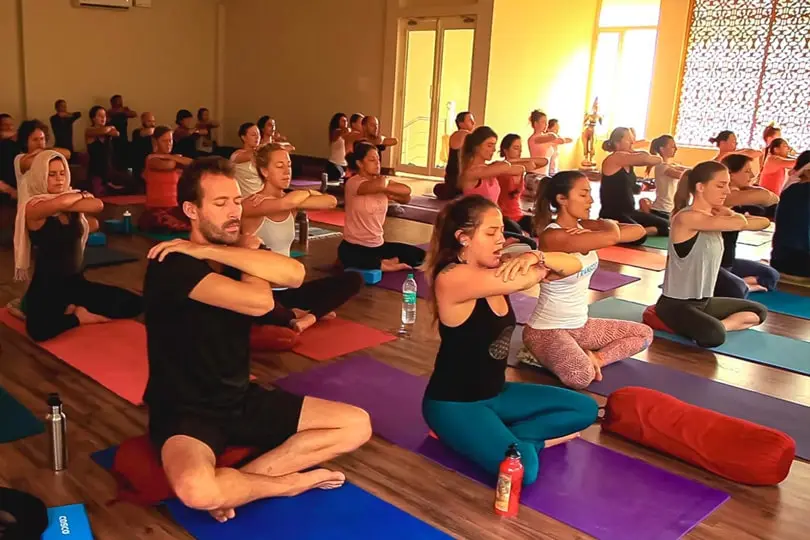
Participating in Virtual Retreats
As part of Yoga teacher training online courses, virtual retreats have emerged as a valuable component, simulating the immersive experience of traditional retreats in a digital format. Here’s how to maximise the benefits of online yoga retreats and effectively network with peers and mentors.
The Rise of Online Yoga Retreats
Accessibility and Convenience: Online retreats have gained popularity as they break down geographical barriers, allowing participants from all over the world to join without the need for travel.
Variety of Offerings: These retreats often feature a range of activities, from guided yoga sessions and meditation to workshops on yoga philosophy and anatomy. This diversity allows participants to explore different facets of yoga more deeply.
Adaptability: Unlike traditional retreats, online versions can be more flexible, offering recordings for those who cannot attend live sessions, thereby accommodating different time zones and schedules.
How to Maximise the Benefits of Online Yoga Retreats
Active Participation: Engage actively during sessions. Use chat functions to ask questions, participate in discussions, and share insights. The more you interact, the richer your experience will be.
Dedicated Space: Create a quiet, dedicated space in your home where you can attend the retreat without interruptions. This helps emulate the focused environment of a physical retreat.
Preparation: Before the retreat starts, prepare by reviewing the schedule and planning your days. This preparation helps you manage time effectively and ensures you don’t miss key sessions.
Tips for Networking and Learning from Peers and Mentors
Use Breakout Rooms: Many virtual retreats use breakout rooms for smaller group interactions. These are excellent for building closer relationships and engaging in more personal discussions.
Follow Up: After meeting peers or mentors, follow up with them via social media or email. Express gratitude for shared insights and keep the lines of communication open.
Collaborate on Projects: Propose collaborative projects or study groups with new contacts. This can extend learning beyond the retreat and deepen professional connections.
Feedback and Reflection: Seek feedback from mentors and offer your reflections on the experience. This exchange can lead to valuable insights and continued mentorship.
Conclusion
The journey through Yoga teacher training online courses offers a unique opportunity to explore and maximise learning in innovative ways. By leveraging digital tools, personalising learning pathways, and immersing oneself in a supportive online community, students can transform their training experience into something profoundly enriching and effective.
Summarising the Unique Approaches to Maximise Learning
Personalized Learning Pathways: Tailoring your course to fit your specific learning style—be it visual, auditory, or kinesthetic—ensures that you engage with the material in the most effective way possible. Utilising a variety of digital tools to customise your study approach can dramatically enhance understanding and retention.
Multisensory Environments: By creating a learning space that stimulates all senses, you can mirror the immersive experience of physical yoga studios, enhancing concentration and the overall learning experience.
Gamification and Reward Systems: Implementing elements of play, competition, and rewards within your study routine not only makes learning more enjoyable but also increases motivation and aids in the retention of information.
Integration into Daily Life: Microlearning techniques and the use of mobile apps for quick revision make it possible to weave learning seamlessly into your day, ensuring continuous engagement and better assimilation of knowledge.
Community and Networking: Building relationships within digital sanghas and participating in virtual retreats provide emotional support, enhance learning through shared knowledge, and open up networking opportunities that can be invaluable in your future career as a yoga teacher.
Call to Action
Share Your Experience and Tips
As you journey through your “Yoga teacher training online courses,” the insights and experiences you gather are invaluable. Sharing these can significantly help others navigating similar paths.
Contribute Your Story: What strategies have you found most effective in your online yoga training? Did certain routines, digital tools, or study methods enhance your learning? Drop your experiences and advice in the comments below.
Help Build Our Community: Your input enriches our collective knowledge. By sharing, you assist others in overcoming challenges and improving their own learning techniques.
Stay Connected: Sign Up for Our Newsletter
To deepen your engagement with “Yoga teacher training online courses,” consider subscribing to our newsletter. It’s your direct line to a wealth of resources tailored to enhance your training experience.
Why Subscribe to Our Newsletter?
Expert Advice: Receive monthly tips and guidance from yoga training experts.
Exclusive Updates: Get the latest news on course offerings and updates within the online yoga community.
Interactive Content: Participate in subscriber-only webinars and Q&A sessions that dive deeper into the art and science of yoga.
Community Features: Enjoy inspiring stories from other yoga students and teachers, learning about their journeys and breakthroughs.
Take the Next Step in Your Yoga Journey
The world of online yoga training is expansive and ever-evolving. Engaging with it fully means not only participating in courses but also contributing to the broader community and staying informed about new and innovative teaching methods.
Your Voice Matters: Every tip you share and every question you raise helps shape this community. Make your voice heard!
Keep Learning: Our newsletter is designed to keep you at the forefront of yoga education. Sign up today and ensure you never miss out on valuable insights and exclusive community events.
